3
PRACTICE LOVE AND DISCIPLINE
“The essence of leadership is holding your people to the highest possible standard while taking the best possible care of them.”
—COLIN POWELL
Principle 1: Use High Levels of Love and Discipline to Elevate Others
Enthusiastic fans with unrealistic expectations come with the territory of a college football program. Clemson University is no exception to this rule, having a long and storied history complete with a National Championship in 1981, followed by a 15-year period of average achievements. Critics began using the term “Clemsoning” to describe losing to a team of lesser talent regardless if Clemson was involved or not.
Midway through the 2008 season, at what felt like rock bottom to Clemson fans, Coach Tommy Bowden was fired and replaced by Dabo Swinney. An interim choice, Swinney led the Tigers to a 4-3 record to finish the season. Without much luck finding a big-name replacement and a deep belief in an unproven commodity, Clemson’s athletic director, Terry Don Phillips, decided to take a chance on the young Swinney by removing his “interim” tag and naming him the permanent head football coach. Phillips recalled, “I liked the way he coached his players, how he was tough on them but was always teaching them and always there for them outside of football. It’s not a facade with Dabo. He genuinely cares, and his players sense that.”
What transpired over the next 10 years is nothing short of magical. Since Swinney took over not only did Clemson win National Championships in 2016 and 2018, but they have sustained excellence, winning over 79 percent of their games and having nine straight seasons of 10-plus wins. There is no doubt that in 2019, the Clemson Tigers are an elite program, setting the standard for every other college football program in the country.
I spent some time with author and speaker Jon Gordon at a Clemson game late in the 2016 season. Gordon worked with Swinney and knew the football program well. When I asked what made Swinney a standout leader, Gordon’s answer was one that I will never forget. He explained, “I have never seen a leader use love and discipline like him.” Those words, “love” and “discipline” stuck in my head. As a leader of my own team and a parent to two kids, I understood the struggle in balancing the delivery of both. Over the next few days, I couldn’t shake the feeling that there was more to this idea of love and discipline, specifically when it came to building the best and elevating others. The nagging feeling set me and the LearnLoft team on an investigation of the idea.
Specifically, we looked into Swinney himself and found two standout instances in which he effortlessly tied in his use of love and discipline to elevate others. The first occurred with Clemson’s 2015 team. They appeared in their first College Football Playoff game in 27 years. The anticipation by fans was palpable! But in the days prior to the big game, Swinney suspended five players including their star wide receiver, Deon Cain. The majority of the Clemson faithful were in disbelief and downright frenzied at the choice. Swinney did not bat an eye. He said publicly that Cain and others chose not to meet the standards set by the Clemson coaching staff and wouldn’t get the opportunity to play in the game. If the players had eligibility the next year, they could come back to school and make the choices necessary to be a part of the team, but it wouldn’t be that season.
Swinney’s act was pure discipline. The standards were set, and those who chose not to live up to the standards were not allowed to play. Clemson lost the game against Alabama, but Swinney stood by his convictions; he knew he had made the right decision because he was serving his players’ hearts and not their talents. He knew his job wasn’t just to win football games but to build the best men and prepare his players for life after their time at Clemson.
Fast-forward a year later to our second example. The Clemson team found themselves back in the College Football Playoffs, this time in the National Championship game against the University of Alabama. Clemson went on to play one of the most talked-about games in history, coming out victorious. And yes, Deon Cain did return to the team and played a critical role in the game. He caught five passes for 94 yards and made one of the biggest plays in the game late in the fourth quarter to spur a Clemson comeback.
Following the game, a reporter interviewed Swinney. After thanking God, he said, “I told the team at halftime the difference in the game was going to be love.” Swinney didn’t shy away from using the four-letter word on national television.
While the examples Swinney gave us of both love and discipline in a sports team environment were fantastic, we wondered if the same concept would be applicable in the corporate workplace. Specifically, how could the terms “love” and “discipline” translate into a corporate environment? (They aren’t exactly words encouraged by Human Resources.)
We examined the managerial grid model developed in the 1960s by Robert Blake and Jane Mouton. The managerial grid looked at leader effectiveness through the eyes of two critical elements: a concern for people and a concern for production. Blake and Mouton found a direct improvement in leader effectiveness when both a concern for people and concern for production were high. Blake and Mouton’s work provided an example for our team as we began studying the concept of love and discipline further. We wanted to see exactly how the best leaders built the best and elevated others and if love and discipline played a role.
Love and discipline are words that can be ambiguous, so as we continued our research, we gave them both definitions that apply to the workplace.
Love (verb): to contribute to someone’s long-term success and well-being
Discipline (verb): to promote standards in order for an individual to choose to be at his or her best
By using these definitions of love and discipline, we formed a hypothesis: the most effective leaders who elevate others lead with high levels of love and discipline.
Now, real data was needed to determine if our hypothesis was true in the workplace. We conducted an initial study of 300 leaders in various roles ranging from CEOs to frontline managers. Instead of asking these leaders directly about their current leadership styles, we surveyed those who knew how they led the best: their team members.
We evaluated each leader’s effectiveness by averaging responses from the following two statements:
“Our team consistently meets business goals and objectives.”
“Leadership skills are developed within each individual on our team.”
In order to measure love, we asked individuals to rate their leader on four statements using a scale of 1 to 10.
![]() “My leader is genuinely concerned about my life outside of work.”
“My leader is genuinely concerned about my life outside of work.”
![]() “My leader would set me up for a promotion outside of his/her team.”
“My leader would set me up for a promotion outside of his/her team.”
![]() “My leader spends time coaching me towards my goals.”
“My leader spends time coaching me towards my goals.”
![]() “My leader is vulnerable around me.”
“My leader is vulnerable around me.”
We asked them to do the same for discipline.
![]() “My leader is disciplined.”
“My leader is disciplined.”
![]() “My leader encourages team members to be disciplined.”
“My leader encourages team members to be disciplined.”
![]() “My leader has a set of standards for our team.”
“My leader has a set of standards for our team.”
![]() “My leader consistently holds those who do not meet standards accountable.”
“My leader consistently holds those who do not meet standards accountable.”
Scores for both love and discipline were calculated using the average of the four scores. We then plotted the two scores on a graph with love on the horizontal axis and discipline on the vertical axis (Figure 3.1). The data revealed a direct correlation between leaders’ effectiveness and their use of love and discipline.
FIGURE 3.1 Scores for Love and Discipline for All Leaders
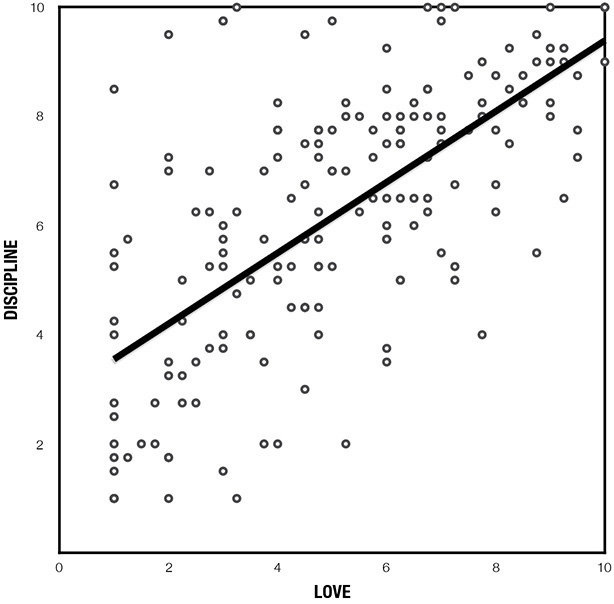
Highly effective leaders were those who leveraged high levels of both love and discipline (Figure 3.2); those leaders who ranked low in effectiveness rated low in their use of love and discipline (Figure 3.3). Our hypothesis was correct!
FIGURE 3.2 Scores for Highly Effective Leaders
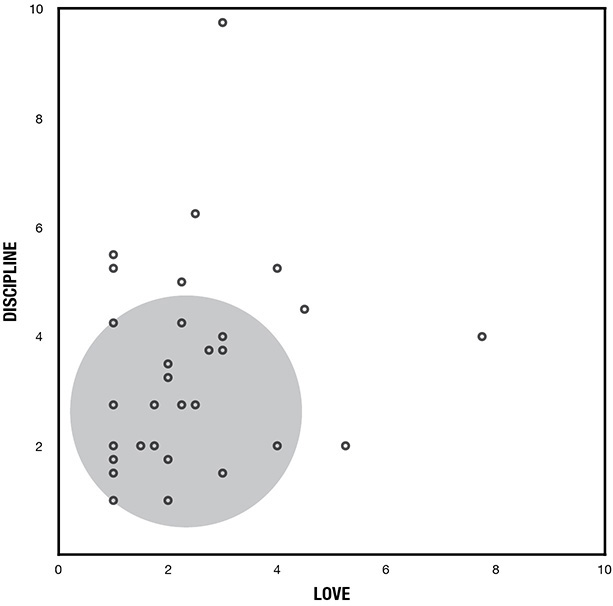
FIGURE 3.3 Scores for Ineffective Leaders
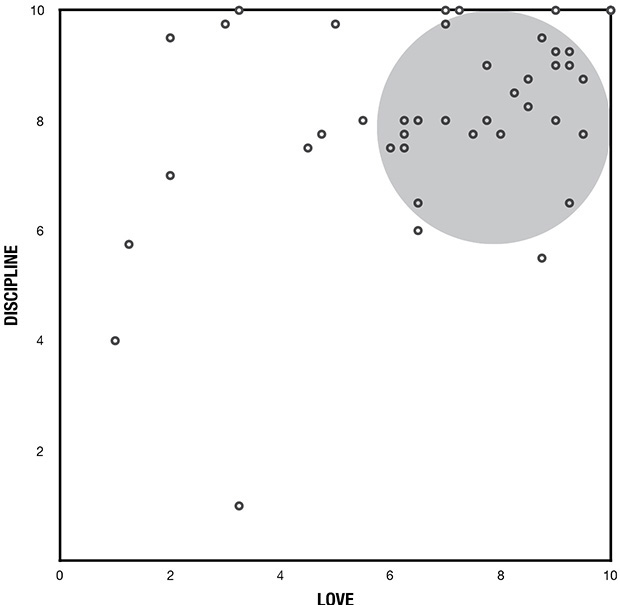
The Five Leadership Styles
More than three years and 40,000 assessments of organizational leaders later, five clear-cut leadership styles emerged (Figure 3.4). Each related to how well a person leverages love and discipline when leading others. While these are current styles of leading, they are not meant to be definitive.
FIGURE 3.4 Five Leadership Styles

Manage
People whose current leadership style is to manage others are often leaders by title alone. They push people along instead of pulling them up. They focus more on themselves than on the people they are supposed to be leading. Because of that, people work for them rather than follow them.
A person with this style:
![]() Scores low in areas of love and discipline
Scores low in areas of love and discipline
![]() Focuses solely on execution
Focuses solely on execution
![]() Lacks great relationships with team members
Lacks great relationships with team members
![]() Directs rather than coaches
Directs rather than coaches
![]() Tends to be shortsighted
Tends to be shortsighted
![]() Looks at the position as one of power and authority
Looks at the position as one of power and authority
![]() Believes he or she makes the best decisions in almost all situations
Believes he or she makes the best decisions in almost all situations
Rule
People whose current leadership style is to rule others take their position extremely seriously. They value their authority and regulations above relationships with people. The thought of not having control or not being the centralized decision maker makes them uncomfortable. To ensure this does not happen often, leaders who rule others create processes and environments that funnel decision making to them in almost all matters. They tend to come across as heartless because of their reliance on the way things “must” be done.
A person with this style:
![]() Scores high in discipline, low in love
Scores high in discipline, low in love
![]() Driven by a set rulebook, rigid
Driven by a set rulebook, rigid
![]() Gets great or bad results quickly
Gets great or bad results quickly
![]() Has a hard time sustaining success because of team burnout
Has a hard time sustaining success because of team burnout
![]() Never heard an excuse he or she liked
Never heard an excuse he or she liked
![]() Creates process before it’s needed
Creates process before it’s needed
![]() Has “favorite” team members
Has “favorite” team members
Please
People whose current leadership style is to please others are generally not comfortable being in a position of authority. They love people and their job, but they expressly avoid having conflict with team members. They tend to give people too many chances and are often naive about the realities of what is going on around them. Their team members like them as people, but there is a lack of respect for them in a professional capacity.
A person with this style:
![]() Scores high in love, low in discipline
Scores high in love, low in discipline
![]() Gets taken advantage of by his or her direct reports
Gets taken advantage of by his or her direct reports
![]() Is often passed over for promotions
Is often passed over for promotions
![]() Gets stuck in low levels of organizational leadership for long periods of time
Gets stuck in low levels of organizational leadership for long periods of time
![]() Treats everyone equally regardless of talent levels
Treats everyone equally regardless of talent levels
![]() Leads a team that tends to underperform
Leads a team that tends to underperform
Support
People whose current leadership style is to support others are good, not great, leaders. The most popular style to fall into, 47 percent of all leaders from our research currently lead this way. They often have good relationships with their team members and achieve business goals and objectives. They struggle, however, with reaching the next level of success as a leader.
A person with this style:
![]() Scores in the middle in love and discipline
Scores in the middle in love and discipline
![]() Has great relationships with some and average to below-average relationships with others
Has great relationships with some and average to below-average relationships with others
![]() Is regarded as a solid contributor in the organization
Is regarded as a solid contributor in the organization
![]() Leads a team that performs well but could be better
Leads a team that performs well but could be better
Elevate
People whose current leadership style is to elevate others simultaneously use high levels of love and discipline. They constantly exceed goals and objectives, have deep relationships with team members, and make a positive impact on the lives of those they lead.
A person with this style:
![]() Scores high in love and discipline
Scores high in love and discipline
![]() Has deep relationships based on mutual respect
Has deep relationships based on mutual respect
![]() Leads a team that consistently exceeds goals
Leads a team that consistently exceeds goals
![]() Helps create more leaders
Helps create more leaders
![]() Is often looked at as a mentor and role model
Is often looked at as a mentor and role model
![]() Often has people seek advice and counsel from him or her
Often has people seek advice and counsel from him or her
Before you make an assumption about your leadership style, it’s important to note that these aren’t personality profiles. These leadership styles are meant to serve as a mirror you can hold up to see how you’re currently leading. Just because your current leadership style is to rule or elevate today doesn’t mean you’re stuck with that style for life. You can improve or you can regress because leadership is a journey and not a destination. The best part is that you decide how you lead others each and every day. You can take a free assessment to uncover your current leadership style at Buildingthebestbook.com/assessment.
One Clear Winner
As our team continued to study all five leadership styles, we asked leaders who completed the assessment to answer three questions in the context of the past two years:
1. What percentage of your team would you consider high performing?
2. What percentage of your direct reports have been promoted?
3. What percentage of voluntary turnover have you had with your direct reports?
FIGURE 3.5 Elevate vs. All Other Styles

The results continue to prove our hypothesis to be true. Those whose current leadership style is to elevate reported having high-performing teams at rates better than all other teams combined. They reported:
![]() 14 percent more top performers
14 percent more top performers
![]() 18 percent more internal promotions of team members
18 percent more internal promotions of team members
![]() 11 percent lower voluntary turnover
11 percent lower voluntary turnover
Those whose style is to elevate outperform all other leadership styles significantly. This realization cemented the idea that building the best requires the use of high levels of love and discipline.
Leaders Whose Leadership Style Is to Elevate Demonstrate These Competencies
Once we identified those leaders whose style is to elevate, we continued to examine their behaviors to uncover how they leverage love and discipline. Sixteen key demonstrable competencies were isolated, eight in love and eight in discipline (Tables 3.1 and 3.2).
TABLE 3.1 Love Competencies
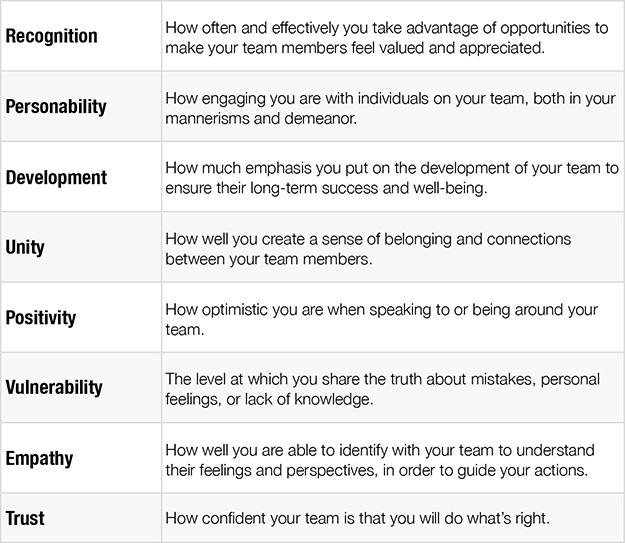
TABLE 3.2 Discipline Competencies
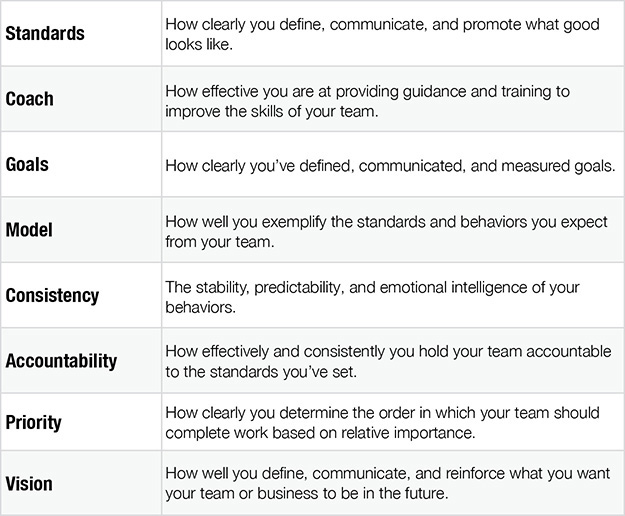
These 16 core competencies are a fantastic barometer to determine specific strengths and weaknesses in the way you lead. All of them are weaved into the chapters, models, and principles I’ll share with you throughout the rest of the book.
Whether you have taken the full 48-question assessment and received your detailed BTB Leader Report or not, it’s important to examine not only what you believe to be your current leadership style, but how well you demonstrate these 16 competencies on the job each day.
The Power of Knowing Your Leadership Style
After studying, coaching, and teaching thousands of leaders, it’s always interesting to see people react to discovering their current leadership style. But the power of the exercise doesn’t lie in crowning anyone the greatest leader ever or chastising those who are less than effective. It’s meant for one simple and powerful reason: to improve self-awareness. Improving in any skill, leadership included, requires a level of self-awareness that opens the heart and mind to do some things differently.
A common practice for officers in the Marines is to put together what they refer to as an Iron Council. This group consists of six direct reports and peers of an officer. A few times a year the Iron Council meets with their officer in a group setting to provide feedback about the leader’s performance over the past few months. The meeting isn’t meant to promote a forum to air petty grievances but rather to provide a constructive place to improve.
Something amazing happens after these Iron Council meetings. While feedback can be tough to hear for most, officers find themselves on a mission to grow and get better. Officers take the opportunity to increase their self-awareness about how they are leading and identify specific things they can do to improve moving forward. When provided with further formal or informal leadership development opportunities, the officers are engaged and take ownership of their education.
Whether you have formed an Iron Council around you or if you have taken the full BTB Leader Assessment and received your individualized report, know that simultaneously leading with high levels of love and discipline isn’t easy. But if you don’t use love, you won’t connect with people to get their best possible performance. If you don’t use discipline, you aren’t going to get anyone to levels they didn’t think possible. If that weren’t enough, it’s tough to be tough on people, and it’s tough to love people when you don’t feel like loving them.
Train Your Mind if You Want to Improve
In the Introduction of this book, I highlighted the research done by Leadership Quarterly showing that leaders aren’t born but instead use a combination of genetics and development. For many people, this is a major change in thinking, but it’s the only way to think if you are going to get better from a leadership perspective or, for that matter, anything.
The development of leadership skills isn’t just about reading this book or practicing the concepts within it during the rest of your career. Instead, the most important factor, if you want to improve, is changing how you think. It could be summarized as having a growth mindset. The growth mindset theory was brought to prominence by Carol S. Dweck, a Stanford psychology professor. In simple terms, it suggests that “we can grow our brain’s capacity to learn and solve problems.”
Dweck wrote in her book Mindset:
[The fixed mindset believes that your qualities are carved in stone and] it creates an urgency to prove yourself over and over. If you only have a certain amount of intelligence, a certain personality, and a certain moral character—well, then you’d better prove that you have a healthy dose of them. . . . The growth mindset is based on the belief that your basic qualities are things you can cultivate through your efforts, your strategies, and help from others. Although people may differ in every which way—in their initial talents and aptitude, interests, or temperament—everyone can change and grow through application and experience. Do people with this mindset believe that anyone can become anything, that anyone with proper motivation or education can become Einstein or Beethoven? No, but they believe a person’s true potential is unknown (and unknowable); that it’s impossible to foresee what can be accomplished with years of passion, toil, and training.
If there is nothing else you learn from this book, whether you adopt it for yourself or pass it along to your people, wrap your heart and mind around this concept. Not only will you start to see failure as feedback instead of failure being final but you will be growing every day rather than being in neutral or going backward.
We are all born with unique DNA. I started with a different makeup than you did. It might be easier for me to handle pressure than it is for you because of my DNA. But you can still learn how to handle pressure effectively. You might have been born with better leadership DNA than I was, but I can still learn how to be an effective leader.
Unfortunately, the majority of professionals fall into the category of having a fixed mindset over a growth mindset. They fall into the trap of believing that talent wins every time and they were either born with the ability to get the job done or they weren’t.
Turns out it isn’t limited to professionals; it happens at every age. My six-year-old son is learning how to read. Each night his teacher sends home two lists of sight words to learn and a short book. Early in the school year, I sat down with him to go through the sight words. The first was a list of words like a, the, with, where, can, and was. We weren’t past the third word before my little man broke down in tears saying, “I can’t do it.” Instead of allowing him to give up, I helped him sound out the next word and gave him positive reinforcement when he said the word correctly. In less than three minutes he got through the list of 30 words. Excited, we moved on to the next block of sight words. Again, we weren’t past the third word before my little man broke down in tears saying, “I can’t do it.” Instead of allowing him to give up, I helped him sound out the next few words followed by an excited “yes!” when he read them correctly. In less than two and a half minutes, he got through the list of 30 words. Next, we moved on to the short book. Again, before we got through the first page, he broke down in tears, crying, “I can’t do it.” Instead of allowing him to give up, I helped sound out the words, and before long he completed the 13-page book. We both erupted in cheers, and I said, “I knew you could do it!” Afterward, I asked him to share with my wife how the homework went. He said, “I got frustrated with my first list of sight words, but then I tried to sound out each word and I did it. Then with my second set of words, I got frustrated again, but I did it. When we got to the book, I was frustrated and wanted to give up, but I kept sounding out the words and I read a whole book by myself!”
Now I share this story not because I believe my son is naturally gifted or because I am naturally gifted as a parent but because all kids come out of the womb not knowing how to read. The way I was able to begin changing my son’s mindset about reading from a fixed mindset to a growth mindset was by focusing on the pattern of what happened to him. In each of the three exercises, he wanted to quit when he didn’t immediately know the answer but eventually, he completed them successfully. Thus a pattern emerged of action, outcome, learning.
You can focus on a similar pattern for yourself around having a growth mindset in life and around the development of your leadership skills. It’s what I call AOL, an acronym that stands for action, outcome, learning (Table 3.3). Let’s take my own development as an example. As a leader of a team, my ability to have effective direct dialogue is a critical skill to develop for myself and my team.
TABLE 3.3 AOL Pattern
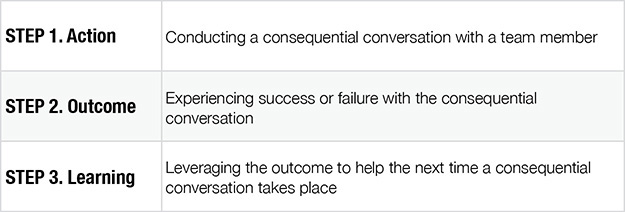
Obviously, this is just one example of AOL in action, but it can be a powerful way to begin making a shift in yourself. Naturally, at this point, you have probably already started to do a brief mental evaluation of whether you have a growth or fixed mindset. While that is fine, I want you to remember that if you currently have a fixed mindset, it doesn’t mean you can’t change. (Remember my six-year-old learning how to read.) It’s your job to ensure you adopt a growth mindset instead of a fixed mindset, and the AOL approach is just one way do that.
Moving from Knowledge to Wisdom
The rest of this book has been designed specifically to help you leverage love and discipline at higher levels and improve your skills in the 16 key leadership competencies to truly build the best and elevate others. I know words in a book mean nothing unless they are put to use because power is not in the knowledge, but rather, the application of knowledge. This became real to me when a mentor of mine shared an important lesson (Figure 3.6):
FIGURE 3.6 Steps to Wisdom
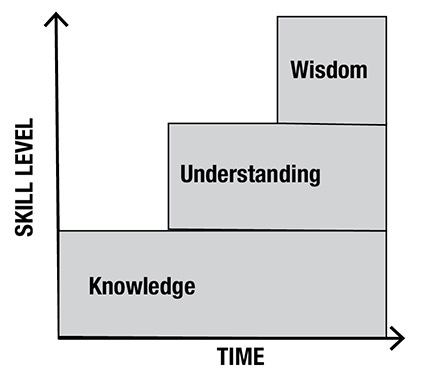
![]() Knowledge is information.
Knowledge is information.
![]() Understanding is comprehension.
Understanding is comprehension.
![]() Wisdom is application.
Wisdom is application.
Karl Popper famously said, “True ignorance is not the absence of knowledge but the refusal to acquire it.” In today’s modern Internet, information is more readily available to more people than at any time in history. Anyone with an Internet connection can find information at little to no cost. That presentation of information is accompanied by the opportunity to comprehend it. Sometimes we can comprehend the information on our own, and other times we might need a teacher, instructor, or expert to help us.
While understanding is an important step, the true test is the ability to apply knowledge. Wisdom and application are supreme as there is so much one could understand, but never apply. A heart surgeon who smokes cigarettes, a diabetic who chooses to eat sugar, or a music student who can read music but cannot play an instrument are all prime examples of comprehending but not applying.
What you should be striving for is gaining a level of wisdom that creates ease of application. I understand this is simple to write and difficult to execute. I have done my best to provide you with the best stories, examples, tools, principles, and resources throughout the rest of the book to transfer knowledge and help you apply it so you can truly elevate others.
Now that you know there is great value in being the best leader you can be, and in order to build the best you have to use high levels of love and discipline, the natural question becomes, “Where do you start, and how do you do it?” We will begin to explore that in the next chapter.
